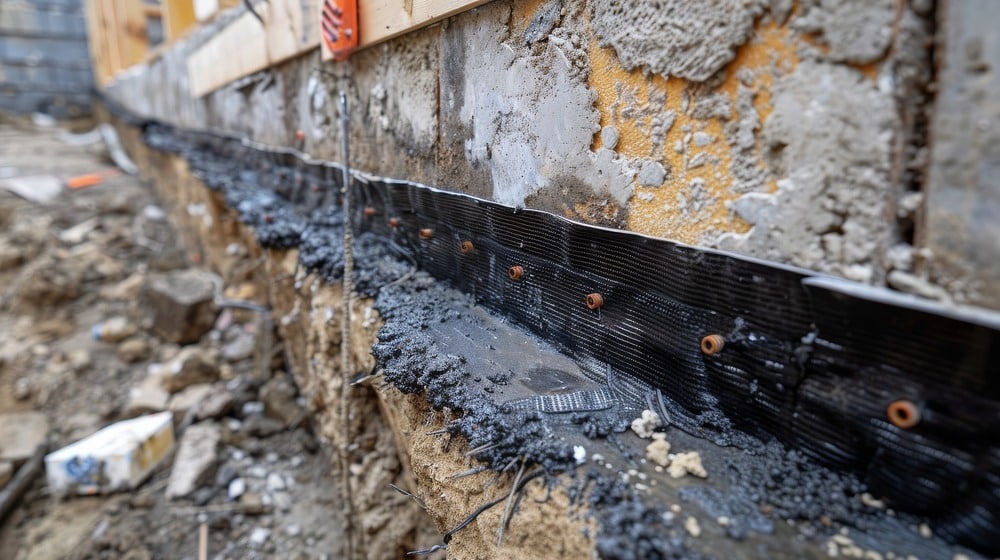
Your foundation keeps your home safe and steady, but over time, soil, water, and shifting ground can cause walls to crack or bow. If these problems aren’t addressed, they can threaten the safety and stability of your entire house. That’s why homeowners turn to carbon fiber straps for foundation repair. They are strong, non-invasive, built to last, and provide a reliable way to reinforce weakened walls. At KC Waterproofing and Foundation Repair, we use carbon fiber straps to stabilize foundations and protect your home for the long run.
What Are Carbon Fiber Straps?
Carbon fiber straps are reinforcement strips made from woven fibers and epoxy. Even though they’re lightweight, they’re stronger than steel and won’t stretch or break under pressure. In foundation repair, these straps are attached directly to the basement or foundation walls to stop bowing. Because they sit flat against the wall, carbon fiber straps add long-term strength without heavy equipment or messy excavation.
How Carbon Fiber Straps Work in Foundation Repair
Carbon fiber straps work for foundation repair because they are lightweight strips that help keep walls steady, stop bowing, and make your foundation strong long-term. Here’s how they work:
- Anchor and stabilize walls: Straps are anchored to the top and bottom of the wall to prevent inward movement of bowed or leaning walls.
- Stop cracks from spreading: Once installed, the strong bond reinforces the wall and prevents further bowing or cracking.
- Non-invasive installation: Straps sit flat against the wall, providing long-term support without the need for excavation or heavy equipment.
- Permanent solution: The result is a secure, long-lasting solution without excavation or heavy equipment.
Types of Carbon Fiber Reinforcement Systems
Carbon fiber reinforcement comes in several options, depending on the foundation problem:
- Carbon Fiber Straps with Epoxy: The standard solution, where straps are bonded to walls with epoxy for strong, long-lasting support.
- Carbon Fiber Straps with Steel Anchors: Straps combined with steel anchors at the top and bottom for extra stability.
- Carbon Fiber Sheets/Mesh: Wider sheets or mesh are used to reinforce larger wall areas or heavily cracked surfaces.
Signs You May Need Carbon Fiber Straps
Carbon fiber straps can help when your foundation shows signs of stress. Look for these warning signals:
- Horizontal or stair-step cracks in the basement or foundation walls.
- Walls bowing inward or leaning due to soil pressure.
- Doors and windows sticking or becoming hard to open and close.
- Gaps between walls, floors, or ceilings indicating separation.
- Visible shifting or leaning of basement walls over time.
Benefits of Using Carbon Fiber Straps
Carbon fiber straps are a modern, easy, and long-lasting way to fix foundation walls. Unlike traditional repairs, they strengthen walls without heavy equipment. Key benefits include:
Non-Invasive Installation
Carbon fiber straps are an easy, non-invasive way to fix foundation walls. Installation is fast and doesn’t need heavy equipment or digging. Your walls, basement, and yard stay intact, and there’s very little disruption, so you can stay in your home while the work is done.
Long-Term Durability
Carbon fiber straps are very strong, stronger than steel, but much lighter. They don’t stretch, crack, or corrode, giving a permanent solution to keep walls stable and provide long-lasting protection against bowing, cracking, and movement, keeping your foundation secure for years.
Cost-Effective Compared to Other Methods
Carbon fiber straps are a strong, long-lasting way to fix foundation walls without the high cost of traditional methods. Installation requires less work and no digging, making it more cost-effective than wall replacement or installing steel beams.
Compatibility with Other Foundation Repairs
Carbon fiber straps are flexible and can be used with other foundation fixes. They work well with waterproofing, drainage, wall anchors, or piers to strengthen walls, making them a good choice for both simple repairs and larger structural issues.
Carbon Fiber Straps vs. Other Foundation Repair Methods
The right repair method depends on how much the wall has moved. For early cracks and bowing, carbon fiber straps are usually the best choice. There are different options for fixing foundation walls, each designed for different levels of damage:
- Carbon Fiber Straps: Ideal for walls with mild to moderate bowing or cracks. They are affordable, quick to install, minimally invasive, and don’t take up interior space.
- Wall Anchors: Best for severely bowed or leaning walls. Wall anchors are effective but require some excavation outside the home.
- Steel I-Beams: Extremely strong, but bulky, and can reduce usable basement space.
- Foundation Replacement: Reserved for extreme cases. Highly disruptive and costly.
Carbon Fiber Straps Installation Process: What to Expect
Thinking about using carbon fiber straps to fix your foundation? You’re probably wondering what the installation process looks like. The good news is that it’s quick, clean, and straightforward. Here’s a step-by-step look at the process and what you can expect along the way:
Professional Assessment & Wall Measurement
The process starts with a thorough inspection of your foundation. A technician looks for cracks or bowing to confirm if carbon fiber straps are the right fix. Then, they measure the walls to determine the best placement for the carbon fiber straps.
Surface Prep
Before installing carbon fiber straps, the wall needs to be prepared. A professional smooths the wall and cleans off dirt, dust, or loose material, which helps the epoxy stick properly so the straps can prevent future movement.
Epoxy Application & Strap Placement
After the wall is prepped, strong epoxy is applied. The carbon fiber straps are then placed vertically from top to bottom to hold the wall in place, which keeps the wall stable and prevents more bowing or cracking.
Post-Installation Considerations
Once the epoxy has hardened, the straps can be painted to match your walls, providing a clean look while maintaining the wall’s strength and stability.
How Much Do Carbon Fiber Straps Cost?
The cost of installing carbon fiber straps depends on the size of your foundation and the number of straps required. If your walls are larger or the damage is more severe, you may need additional straps or reinforcement methods, which can increase the total cost. However, carbon fiber straps tend to be more affordable and cost-effective than steel beams or wall anchors. They provide strong and lasting support to help keep your foundation stable and secure.
Final Thoughts
Worried about bowing or cracked foundation walls? Carbon fiber straps are a strong, long-lasting, and affordable way to fix them. They are lightweight, easy to install, and can be used with other foundation solutions to keep your walls stable. If you notice cracks, bowing, or shifting in your walls, a professional inspection can determine if carbon fiber straps are the right solution for your home. At KC Waterproofing and Foundation Repair, we have been helping homeowners ensure the safety and stability of their foundations for decades.
FAQs
How long do carbon fiber straps last?
When properly installed and maintained, carbon fiber straps are built to last a lifetime. They stay strong over time and provide lasting support for your foundation walls without needing frequent repairs or replacements.
Do carbon fiber straps work on severely bowed walls?
Carbon fiber straps are most effective for walls with mild to moderate bowing. For walls that are severely bowed or heavily damaged, additional support, such as steel beams, wall anchors, or piers, may be necessary to maintain the foundation’s stability and safety.
Are carbon fiber straps visible after installation?
No, carbon fiber straps sit flat on your walls and can be painted to blend in. They give strong, lasting support without changing the look of your basement.
When should you choose carbon fiber straps for foundation repair?
Carbon fiber straps work best when you notice the first signs of bowing or cracking in your walls. They are strong, affordable, and easy to install, helping keep your home stable and preventing bigger problems later.










